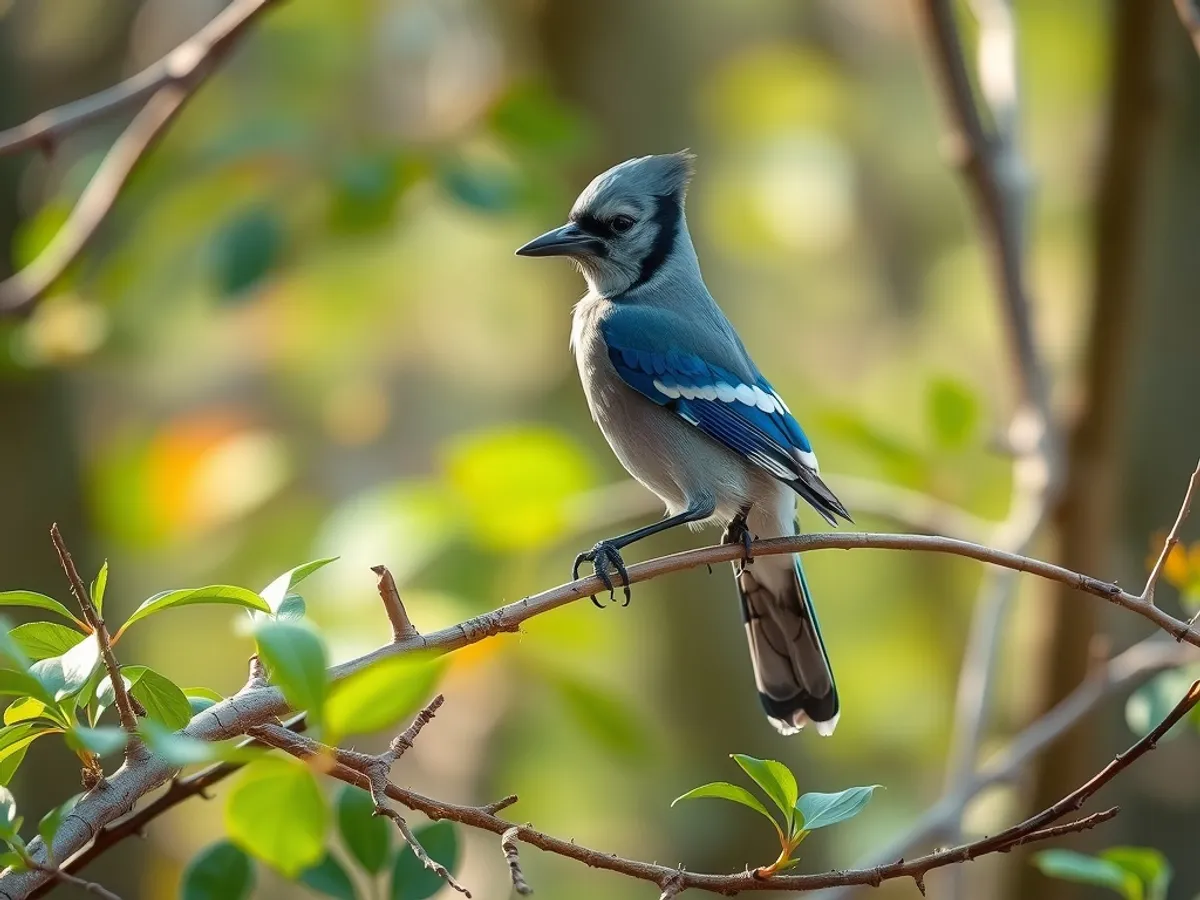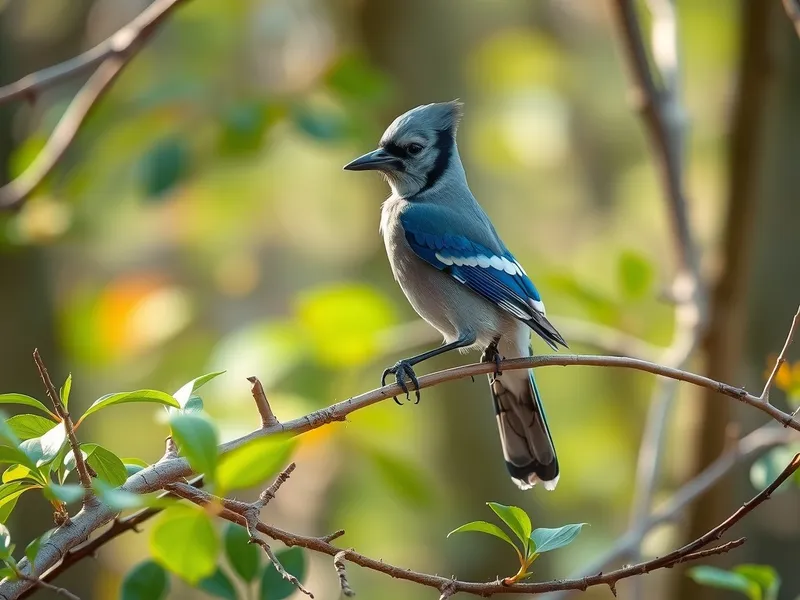
Blue Jay
Cyanocitta cristata

Meet the Blue Jay
The Blue Jay is a striking songbird native to North America, easily recognized by its vibrant blue, white, and black plumage and a prominent crest. Known for their intelligence and complex social behavior, Blue Jays are often observed mimicking the calls of other birds, especially hawks. These birds are highly adaptable, thriving in a variety of wooded habitats and even suburban areas. Blue Jays are also notable for their strong family bonds and their tendency to cache food for later consumption.
Classification
Bird
Habitat
Deciduous and mixed forests, especially those with oak trees; also found in parks and residential areas
Diet
Omnivore
Lifespan
7–9 years in the wild
Conservation
Least Concern
Weight
70–100 grams
📖Fascinating Facts
Brilliant Colors
Despite their vivid blue appearance, Blue Jays' feathers are actually brown; the blue color is a result of light scattering through microscopic structures in the feathers.
Master Mimics
Blue Jays can perfectly mimic the calls of hawks, which can be used to scare away other birds or alert their own group to danger.
Forest Helpers
By caching acorns and sometimes forgetting where they are, Blue Jays contribute to the dispersal and growth of oak forests.
📋Detailed Description
The Blue Jay (Cyanocitta cristata) is a medium-sized passerine bird, measuring approximately 25–30 cm (10–12 in) in length with a wingspan of 34–43 cm (13–17 in), and weighing between 70–100 grams (2.5–3.5 oz). Its plumage is characterized by a vibrant blue upper body, a white face and underparts, and distinctive black markings, including a U-shaped collar and barring on the wings and tail. The blue coloration is not due to pigment but results from structural coloration—microscopic structures in the feathers scatter light to produce the blue hue. Blue Jays possess a strong, slightly curved bill adapted for cracking nuts and seeds, and robust legs for hopping and perching. Their crest is highly expressive, raising or lowering in response to agitation, excitement, or aggression. The species is known for its remarkable vocal versatility, capable of producing a wide range of calls, including complex mimicry of hawks and other birds. Blue Jays are highly intelligent, exhibiting problem-solving abilities, tool use, and complex social behaviors. They are omnivorous, feeding on a varied diet that includes acorns, seeds, fruits, insects, and occasionally small vertebrates or eggs. Blue Jays are year-round residents in much of their range, with some northern populations exhibiting partial migration. Socially, they form loose family groups outside the breeding season and are often seen in small flocks, especially during fall migration.
💡 Did you know?
Blue Jays are responsible for helping spread oak trees, as they often bury acorns which later grow into new trees.
🔬Research & Sources
Wikipedia Summary
The blue jay is a passerine bird in the family Corvidae, native to eastern North America. It lives in most of the eastern and central United States; some eastern populations may be migratory. Resident populations are also in Newfoundland, Canada; breeding populations are found across southern Canada. It breeds in both deciduous and coniferous forests, and is common in residential areas. Its coloration is predominantly blue, with a white chest and underparts, and a blue crest; it has a black, U-shaped collar around its neck and a black border behind the crest. Males and females are similar in size and plumage, which does not vary throughout the year. Four subspecies have been recognized.
Last Modified: 6/2/2025
🎭Behavior & Social Structure
Blue Jays are diurnal and highly active, spending much of the day foraging in trees and on the ground. They are known for their bold and inquisitive nature, often investigating novel objects and environments. Their feeding behavior is opportunistic; they use their strong bills to crack open nuts, especially acorns, which they frequently cache for later consumption—a behavior that plays a significant role in oak forest regeneration. Blue Jays are also known to raid bird nests for eggs and nestlings, though this is a minor part of their diet. Social interactions are complex; they communicate through a variety of vocalizations and body language, including crest position and tail flicking. They are territorial during the breeding season but may form mixed-species flocks in winter. Blue Jays exhibit mobbing behavior, cooperating to drive away predators such as hawks and owls. Their daily routine includes periods of active foraging interspersed with preening, socializing, and vocalizing.
👶Reproduction & Life Cycle
Blue Jays are monogamous, forming long-term pair bonds that may last for several years. Courtship involves mutual feeding, vocalizations, and aerial displays. Breeding typically occurs from March to July, with timing varying by latitude. Nests are constructed by both sexes, usually in the fork of a tree branch 3–10 meters (10–33 ft) above ground, and are made of twigs, grass, and mud, sometimes incorporating human-made materials. The female lays 3–7 pale blue or greenish eggs with brown spots, which she incubates for 16–18 days while the male provides food. Both parents participate in feeding the altricial chicks, which fledge at 17–21 days post-hatching. Parental care continues for several weeks after fledging, with juveniles remaining in family groups through late summer.
🛡️Adaptations & Survival
Blue Jays exhibit several notable adaptations. Their strong, versatile bill allows them to exploit a wide range of food sources, from hard nuts to insects. Their ability to cache food, particularly acorns, is an adaptation to seasonal food scarcity and contributes to forest ecology by aiding seed dispersal. Their plumage provides camouflage in dappled forest light, while the expressive crest and complex vocalizations facilitate nuanced social communication. Blue Jays' intelligence and problem-solving skills are advanced among songbirds, enabling them to adapt to changing environments, including urban and suburban habitats. Their mimicry of hawk calls may serve to deter predators or competitors from food sources.
📚Research Sources
🎨Cultural Significance
Blue Jays hold a prominent place in North American folklore and culture. They are often associated with intelligence, resourcefulness, and assertiveness. In some Indigenous traditions, the Blue Jay is seen as a trickster or messenger. Their striking appearance and bold behavior have made them popular subjects in art, literature, and as mascots for sports teams and educational institutions. The Blue Jay is also the provincial bird of Prince Edward Island, Canada. Their mimicry and vocal prowess have inspired both admiration and superstition among birdwatchers and the general public.
🔬Recent Research & Discoveries
Recent research has focused on the Blue Jay's role in forest ecology, particularly its effectiveness as an acorn disperser and its impact on oak regeneration. Studies using radio telemetry and stable isotope analysis have provided insights into their partial migratory behavior and the factors influencing migration, such as food availability and weather patterns. Ongoing research into their vocalizations has revealed sophisticated mimicry and context-dependent communication, suggesting advanced cognitive abilities. Genetic studies have clarified the relationships among the four recognized subspecies and their historical biogeography. Blue Jays are also increasingly used as model organisms in studies of avian cognition and urban ecology.
🎥Wildlife Videos

The Surprising Life of a Blue Jay - Documentary
In this video, we take a look at one of the world's most interesting birds, a bird whose intelligence may have long been ...
Fire of Learning

A blue jay struggle | a wildlife documentary
If you find anything in this video helpful or interesting subscribe and leave a like. If you have any suggestions or tips leave a ...
Derek.productions

10 Fun Facts About Blue Jays | Noisy, Beautiful, Interesting
Love or hate them you can't deny the fact that Blue Jays are beautiful, interesting, and clever. Here are 10 fun facts about this ...
Lesley the Bird Nerd

A Bird I've Known the Longest - The Blue Jay
This video is an overview of the Blue Jay and will help you learn more about what they look like, some calls and sounds to listen ...
Lesley the Bird Nerd

Wildlife Bird: The Beautiful Blue Jay Bird | Animal Documentary
Welcome to Morning Fairy Tale, your ultimate destination for enchanting animal fairy tales, and cartoon story tales! Dive into a ...
Animal Fairy Tale

4 Things You Didn't Know About Blue Jays
There's Much More to Blue Jays than Pretty Feathers Lesley the Bird Nerd Merchandise https://www.lesleythebirdnerd.com Also, ...
Lesley the Bird Nerd
🌍Habitat Information
The Blue Jay typically inhabits Deciduous and mixed forests, especially those with oak trees; also found in parks and residential areas environments. Blue Jays have adapted to their environments with specialized features and behaviors.
Primary Habitat:
Deciduous and mixed forests, especially those with oak trees; also found in parks and residential areas
More detailed habitat information will be available soon.
🛡️Conservation Status
The Blue Jay is currently classified as Least Concern. Conservation efforts are crucial for preserving this species for future generations.
Common Threats:
- 🏠Habitat loss and fragmentation
- 🌡️Climate change impacts
- 🎯Hunting and poaching
- 🏭Human-wildlife conflict
⚠️Threats & Conservation Challenges
Currently, Blue Jays are classified as Least Concern by the IUCN, with stable or increasing populations across most of their range. However, they face localized threats from habitat loss due to urbanization and deforestation. Collisions with windows and predation by domestic cats are significant sources of mortality in suburban areas. West Nile virus outbreaks have caused regional declines, but populations have generally recovered. Climate change may alter their range and the availability of key food resources, such as acorns. Despite these challenges, their adaptability and generalist diet have allowed them to thrive in a variety of environments.
🔬Scientific Classification
Scientific Name
Cyanocitta cristata
Classification Hierarchy
🔍 About Taxonomic Classification
Taxonomic classification is a hierarchical system used by scientists to classify and organize living organisms based on shared characteristics and evolutionary relationships.
The system moves from broad categories (Kingdom) to increasingly specific ones, with each animal's scientific name typically consisting of its Genus and species.
📝Community Notes
Share your observations and insights about the Blue Jay with our community of wildlife enthusiasts.
Join Our Community
Sign in to share your observations and connect with fellow wildlife enthusiasts.
Sign In to ContributeNo community notes yet
Be the first to share your observations about the Blue Jay!
Explore Blue Jay
Select a tab above to learn more about this amazing animal.
📸Photo Gallery
No photos available for this animal yet.
🌟Discover More Wildlife
Continue your journey of discovery with more fascinating animals from our database
